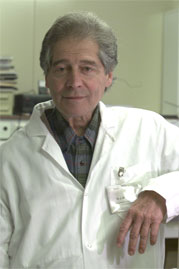
Dr. Jacques Benveniste died Sunday evening October 3rd at the Pitié-Salpétrière Hospital in Paris, France.
Jacques Benveniste's funeral will be held in Paris on Thursday, October 7 at 2:45 PM. Gathering at the main entrance of the Père Lachaise cemetery, Bvd de Ménilmontant Paris, 20th.
Mr. Benveniste was born on March 12, 1935 in Paris, France. Following his studies in medical school, he practiced medicine in Parisian Hospitals, before serving as senior registrar for the French Medical School. Early on, he dedicated himself to research, in France and in the USA. He began working for INSERM (Institut de la Santé et de la Recherche Médicale – French National Institute of Health and Medical Research,) in 1973 where he was the head of several departments (25, 131, 200) and in 1984 was appointed senior Research Director.
Throughout his long career, Jacques Benveniste published more than 300 scientific articles and gained worldwide fame with his “Platelet Activating Factor” (PAF) discovery in 1970.
On June 20, 1988, his work made the headlines in the French daily Le Monde : “A French discovery shakes our concept of Physics”, which itself was taken from an article yet to appear in the very highly regarded British Scientific Magazine, “Nature”. Research led by the distinguished Dr. Benveniste had uncovered one of the main molecules responsible for asthma. Close consultant to Jean-Pierre Chevènement, French Minister for Research between 1981 and 1983, he worked on the discovery with 13 other biologists, both French and foreign. These 13 colleagues confirmed and co-signed the incredible experiment that he published under the title: “The degranulation of human basophils induced by high dilutions of an anti-IGE-anti-serum.” In other words, the researcher affirmed having been able to make a blood cell react with a totally diluted solution of water having contained an antibody. The biological information was transmitted despite the molecule’s absence. Hence Dr. Benveniste concluded, “Water has a memory”.
At this point, although his findings deeply shook the scientific world, instead of returning to a more orthodox path, he forged ahead. Changing his experimental protocol several times in order to give a better basis for his results, he was able to gradually propose an explanation to this phenomenon, which up until then had been elusive. He concluded that for each active molecule, there is a corresponding electromagnetic signal. Even when successive dilutions showed no presence of the molecule, the signal remained active. Thus he was able, year after year, against all odds, to reveal this “unexplainable” phenomenon – an even greater feat due to his modest means.
The effects of high dilutions were reproduced a total of 7 times in 6 international laboratories, completely independent of his own, as well as more than a thousand times in his own laboratory, which he even equipped with a robot to carry out the experiments without the need for human intervention. How many times must an experiment be carried out before a scientific fact is considered to be “reproducible”?
Controversies on the subject have always detected errors, artifacts, or untruths, but all of which were set straight within months. For the past 15 years, nothing has disproven Dr. Benveniste’s findings.
On the contrary, research was able to continue and benefit numerous scientific partnerships. Both the support from INSERM – which kept him in his position, then named him emeritus when he was to retire – and the support he received from the last two French Presidential teams, enabled him to continue his research.
Moreover, his entourage set up a company, DigiBio , founded in 1997, with powerful partners, which enabled him to continue to finance his research. A North-American firm has bought the non-exclusive rights to the company's seven patents. One of these -- dealing with wireless digital biology, i.e. recording and transmitting biological activity as ".wav" sound files -- has been validated by the US Patents Office.
This became possible, after a series of blind experiments. An anticoagulant remedy was digitalized in San Diego by this process. The file/signal received at INSERM by electronic mail was transmitted to water, which in turn inhibited the coagulation in the same way the original molecule had. See: www.digibio.com/video.
The purchase of these rights is a sign that a new approach, with a wide range of possible applications, is emerging in biology, for example, detectors of toxic or microbe pollutants, whether accidental or criminal, electro-magnetic virus antibodies, etc.
Those close to Jacques Benveniste are determined to support the research, which is being deployed throughout the world in digitalized biology.
Promoting his work will contribute to sustaining freedom in research, putting emphasis on fact as opposed to received ideas, which, while drawing human communities together, can also hold back major innovations.
"When the fact that we come up against does not agree with the predominant theory we have accepted, we must take the fact and abandon the theory" (Claude Bernard)
Among scientifics that can testify of his work:
Contact : Laurent Benveniste — +33 6 12 31 20 75 — laurentbenveniste@wanadoo.fr
Born March 12, 1935 ; father of 5 children